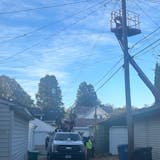Frazzled.
That word describes how springtime's birds must feel, migrants and residents both.
The birds now flooding in from their winter homes are eager to claim territories and step up for the breeding sweepstakes. Residents, like cardinals and chickadees, also are gearing up and preparing to court and claim a mate.
They're all in a rush, because there never are enough prime territories, so the earliest and the most dominant birds get the best sites. And they're singing up a storm to attract a top-tier mate, able to help produce a successful batch of youngsters.
There's no time to waste. They need to pair up, build a nest, breed and then spend several weeks incubating eggs. And then two weeks or more feeding their growing brood. And still their job isn't finished, because after young birds leave the nest, they need several weeks under their parents' wing, so to speak, to learn how to survive on their own.
One of the most amazing things about this mad-dash season is that it's not over when it's over, for many birds. Cardinals and bluebirds, robins and hummingbirds, house wrens and phoebes turn right around, build a second nest and raise a second brood each summer.
Here's another astonishing thing about nesting season: Every bird builds the kind of nest that's particular to its species but they've never seen one being built. Think of the robins' mud-based cup and the wrens' jumble of twigs. No one showed robins how to gather mud and tamp it down the first time they make a nest. And no older wren showed a young male wren how to gather hundreds of twigs to stuff into a tree hole or nest box.
Birds are going by plans stored in their brains, because they weren't around to watch their parents build a nest. As they get older, their nest-building skills improve, but even so, they do a pretty good job that first time around.

